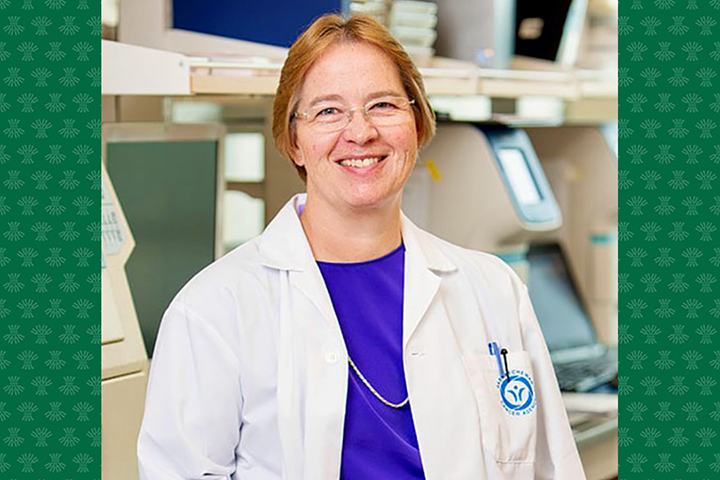
Game-Changer: Dr. Deborah Anderson on Triple Negative Breast Cancer
A profile of one of Saskatchewan’s top cancer researchers
By RESEARCHERS UNDER THE SCOPEListen to all episodes of Researchers Under the Scope podcast.
Subscribe to the podcast on Spotify or Apple Podcasts
Breast cancer is one of the single most common cancers in women. But a patient’s survival rate depends on the type of cancer — and on whether or not that cancer has started to metastasize and move from one part of the body into another.
Dr. Deborah Anderson (PhD) has spent her career as a biochemist and cancer cell biologist pinning down elusive targets.
Now she’s made a breakthrough in one of the world’s most swift-moving and aggressive cancers: triple negative breast cancer.
This form of the disease affects 15 to 20 per cent of women diagnosed with breast cancer. It’s often more prevalent in young women, with a disproportionate number of Black and Latina women. Unlike other forms of breast cancer, it’s not fuelled by the hormones estrogen and progesterone, or by the HER2 protein — and so does not respond to typical hormonal therapies.
For Anderson, Director of Research at the Saskatchewan Cancer Agency, unraveling biochemical mysteries has always been a passion.
‘Hooked' on science, cell function and behaviour
During her third year as a pre-med student at the University of Manitoba, she switched to an honours biochemistry program.
“I got to learn more about things like the fundamental processes going on in cells, controlling cell functions, cell behaviour, and this just reinforced my interest and love of science and I was hooked,” said Anderson.
After completing her doctoral studies, she went on to work in laboratory of the late Tony Pawson — a scientist Nature magazine calls ‘one of the most extraordinarily gifted and celebrated molecular and cellular biologists of our time.’
Pawson honed in on the Src homology 2 (SH2) domain, a segment of protein that folds and forms to create phosphotyrosine-recognition patterns, with binding and structures that almost resemble Tetris blocks, or LEGO.
The discovery shed more light on the language cancer cells use to relay messages.
“He was the one who really said [SH2s] must be important. So it was really cool and exciting to be in his lab at that time,” Anderson said. “Now there are literally hundreds of these modular protein domains.”
Speed of laboratory sequencing accelerates
Today, Anderson is a professor of oncology in the College of Medicine at the University of Saskatchewan. It started with her move west in 1991, when she accepted a faculty position, opening what was then a brand-new laboratory.
“We were just starting to learn how to make controlled, known mutations, to sort of probe what those different mutations would do to the protein that they were in,” said Anderson.
“Now you can sequence the whole genome — 20,000 genes and more in a day for a thousand dollars. So the technology has definitely changed what we can do and how fast we can do it.”
Over the past decade, Anderson and her research team have looked at CREB3L1, a protein that sits on a person’s DNA and helps decide whether or not to switch on the genes that stop cancer from spreading.
CREB3L1 is missing inside metastatic cancer cells, leading Anderson to question which proteins are active there instead.
’The brakes are often missing’ in cancer cells
“This is a common thing in cancer where things that put on the brakes are often missing,” Anderson said.
In this episode, she explains how she and her team of six researchers have now identified a protein that promotes metastasis — one that’s often observed in triple negative breast cancer. It has no natural inhibitors, and its three-dimensional folded structure is already mapped out.
To figure out what might stop this protein, Anderson teamed up with an American company specializing in small molecule analysis, to figure out what types of compounds would ‘fit’ inside this new metastasis promoting protein.
She narrowed down promising compounds, then turned to medicinal chemist Dr. Brent Page at the University of British Columbia for help creating the most effective therapeutic version.
“He’s adding on different groups to make it bind better, tighter, to make it more soluble, to make it more stable in the bloodstream so it doesn’t disappear right away,” said Anderson. “We’re going to test them in the lab to see which ones actually work even better.”
Breakthroughs could be triple negative breast cancer 'game-changer'
Even though this drug compound has years of safety and toxicity trials ahead, Anderson said this could eventually be a ‘game-changer’ for triple negative breast cancer patients.
“These cytotoxic chemotherapy agents are nasty,” said Anderson. "Patients often ask themselves, is this really worth it to go through all this for the time that it buys me?”
At the same time, Dr. Anderson and her team are also looking at existing pharmaceuticals approved by the U.S. Food and Drug Administration — and whether any of them are effective against triple negative breast cancer cells.
To date, she said four drugs look promising, particularly in combination with existing chemotherapy drugs. Because they’re already FDA-approved, it’s a far less onerous process to eventually get them to oncologists and their patients.
“We're hoping with this combination therapy, we can interest that pharmaceutical company that holds the rights for one of those compounds, to fund a clinical trial,” Anderson said.
“If we could offer patients something that was less cytotoxic, that's still providing them with improved survival and benefit in terms of disease control — that would be huge.”
